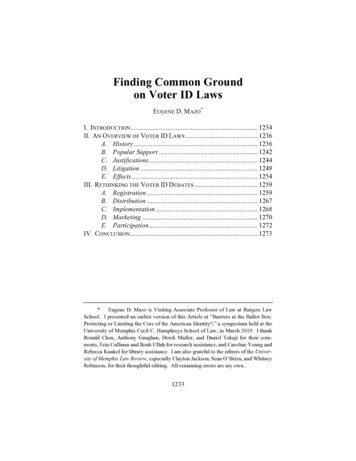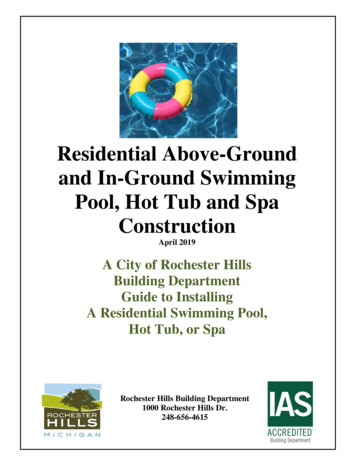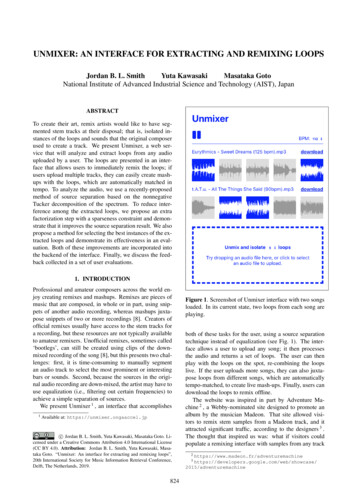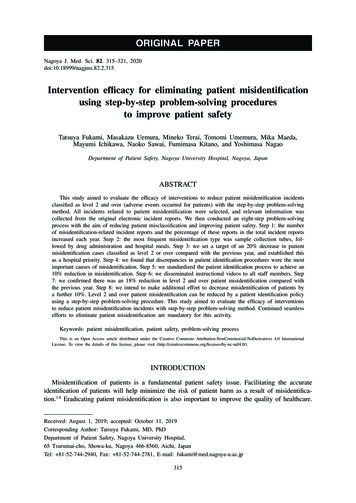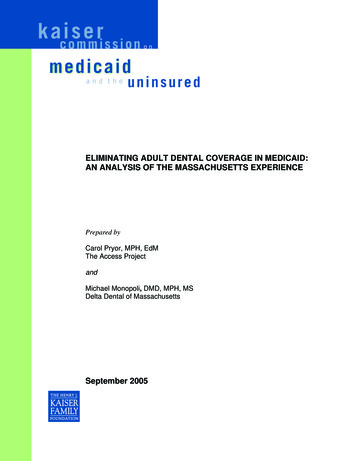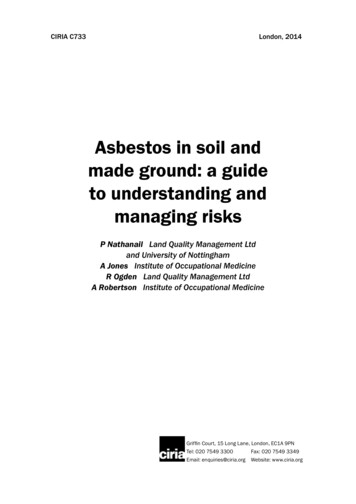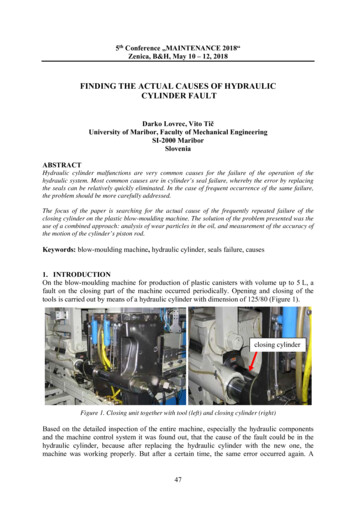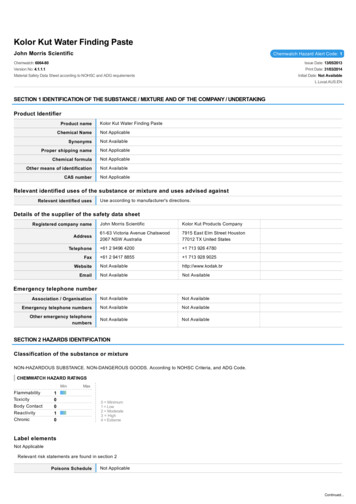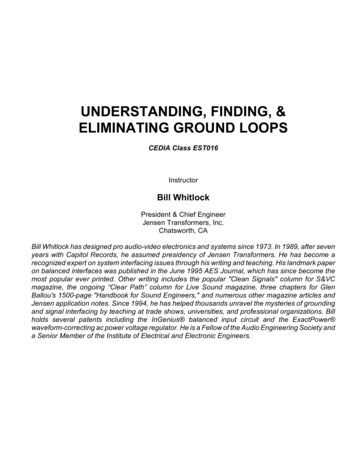
Transcription
UNDERSTANDING, FINDING, &ELIMINATING GROUND LOOPSCEDIA Class EST016InstructorBill WhitlockPresident & Chief EngineerJensen Transformers, Inc.Chatsworth, CABill Whitlock has designed pro audio-video electronics and systems since 1973. In 1989, after sevenyears with Capitol Records, he assumed presidency of Jensen Transformers. He has become arecognized expert on system interfacing issues through his writing and teaching. His landmark paperon balanced interfaces was published in the June 1995 AES Journal, which has since become themost popular ever printed. Other writing includes the popular "Clean Signals" column for S&VCmagazine, the ongoing “Clear Path” column for Live Sound magazine, three chapters for GlenBallou's 1500-page "Handbook for Sound Engineers," and numerous other magazine articles andJensen application notes. Since 1994, he has helped thousands unravel the mysteries of groundingand signal interfacing by teaching at trade shows, universities, and professional organizations. Billholds several patents including the InGenius balanced input circuit and the ExactPower waveform-correcting ac power voltage regulator. He is a Fellow of the Audio Engineering Society anda Senior Member of the Institute of Electrical and Electronic Engineers.
CEDIA EST016UNDERSTANDING, FINDING, & ELIM INATING GROUND LOOPSPage 2TABLE of CONTENTS0 - INTRODUCTION . . . . . . . . . . . . . . . . . . . . . . . . . . . . . . . . . . . . . . . . . . . . . . . . . . . . . . . . . 30.1 - How Quiet Is Quiet? . . . . . . . . . . . . . . . . . . . . . . . . . . . . . . . . . . . . . . . . . . . . . . . . 30.2 - Myths about Earth Grounding and Wires . . . . . . . . . . . . . . . . . . . . . . . . . . . . . . . . 31 - GROUNDING, AC POWER, AND SAFETY . . . . . . . . . . . . . . . . . . . . . . . . . . . . . . . . . . . . 51.1 - Protection from Defective Equipment . . . . . . . . . . . . . . . . . . . . . . . . . . . . . . . . . . 51.2 - Protection from Lightning . . . . . . . . . . . . . . . . . . . . . . . . . . . . . . . . . . . . . . . . . . . . 71.3 - The Facts of Life about AC Power . . . . . . . . . . . . . . . . . . . . . . . . . . . . . . . . . . . . . 81.4 - It’s Not Just 60 Hz . . . . . . . . . . . . . . . . . . . . . . . . . . . . . . . . . . . . . . . . . . . . . . . . . 92 - UNBALANCED AUDIO INTERFACES . . . . . . . . . . . . . . . . . . . . . . . . . . . . . . . . . . . . . . . 102.1 - Interfaces and Impedances . . . . . . . . . . . . . . . . . . . . . . . . . . . . . . . . . . . . . . . . . 102.2 - Matching and Termination . . . . . . . . . . . . . . . . . . . . . . . . . . . . . . . . . . . . . . . . . . 112.3 - How the Noise Gets In . . . . . . . . . . . . . . . . . . . . . . . . . . . . . . . . . . . . . . . . . . . . . 112.4 - Finding the Problem Interface . . . . . . . . . . . . . . . . . . . . . . . . . . . . . . . . . . . . . . . 122.5 - Solutions . . . . . . . . . . . . . . . . . . . . . . . . . . . . . . . . . . . . . . . . . . . . . . . . . . . . . . . 142.6 - Where to Break the Loop . . . . . . . . . . . . . . . . . . . . . . . . . . . . . . . . . . . . . . . . . . . 172.7 - CATV and Satellite TV Dishes . . . . . . . . . . . . . . . . . . . . . . . . . . . . . . . . . . . . . . . 182.8 - Isolation for Digital Interfaces . . . . . . . . . . . . . . . . . . . . . . . . . . . . . . . . . . . . . . . 192.9 - Choosing Cables . . . . . . . . . . . . . . . . . . . . . . . . . . . . . . . . . . . . . . . . . . . . . . . . . 192.10 - A Checklist . . . . . . . . . . . . . . . . . . . . . . . . . . . . . . . . . . . . . . . . . . . . . . . . . . . . . 213 - BALANCED AUDIO INTERFACES . . . . . . . . . . . . . . . . . . . . . . . . . . . . . . . . . . . . . . . . . 213.1 - A Question of Balance . . . . . . . . . . . . . . . . . . . . . . . . . . . . . . . . . . . . . . . . . . . . . 213.2 - No Truth in Advertising . . . . . . . . . . . . . . . . . . . . . . . . . . . . . . . . . . . . . . . . . . . . 233.3 - Pin 1 Problems and the Hummer . . . . . . . . . . . . . . . . . . . . . . . . . . . . . . . . . . . . . 233.4 - Finding the Problem Interface . . . . . . . . . . . . . . . . . . . . . . . . . . . . . . . . . . . . . . . 243.5 - Solutions . . . . . . . . . . . . . . . . . . . . . . . . . . . . . . . . . . . . . . . . . . . . . . . . . . . . . . . 253.6 - About Cables and Shield Connections . . . . . . . . . . . . . . . . . . . . . . . . . . . . . . . . 263.7 - Unbalanced to Balanced Interfaces . . . . . . . . . . . . . . . . . . . . . . . . . . . . . . . . . . . 283.8 - Balanced to Unbalanced Interfaces . . . . . . . . . . . . . . . . . . . . . . . . . . . . . . . . . . . 304 - VIDEO INTERFACES . . . . . . . . . . . . . . . . . . . . . . . . . . . . . . . . . . . . . . . . . . . . . . . . . . . . 314.1 - The “Hum Bar” . . . . . . . . . . . . . . . . . . . . . . . . . . . . . . . . . . . . . . . . . . . . . . . . . . . 314.2 - Finding the Problem Interface . . . . . . . . . . . . . . . . . . . . . . . . . . . . . . . . . . . . . . . 314.3 - Troubleshooting with a Clamp-On Ammeter . . . . . . . . . . . . . . . . . . . . . . . . . . . . 334.4 - Solutions . . . . . . . . . . . . . . . . . . . . . . . . . . . . . . . . . . . . . . . . . . . . . . . . . . . . . . . 345 - RF INTERFERENCE AND POWER LINE TREATMENTS . . . . . . . . . . . . . . . . . . . . . . . . 385.1 - It Surrounds Us . . . . . . . . . . . . . . . . . . . . . . . . . . . . . . . . . . . . . . . . . . . . . . . . . . 385.2 - Squelching RF . . . . . . . . . . . . . . . . . . . . . . . . . . . . . . . . . . . . . . . . . . . . . . . . . . . 385.3 - Technical Grounding . . . . . . . . . . . . . . . . . . . . . . . . . . . . . . . . . . . . . . . . . . . . . . 395.4 - Power Isolation, Filters, and “Balanced Power” . . . . . . . . . . . . . . . . . . . . . . . . . . 395.5 - Surge Suppression Cautions . . . . . . . . . . . . . . . . . . . . . . . . . . . . . . . . . . . . . . . . 40REFERENCES . . . . . . . . . . . . . . . . . . . . . . . . . . . . . . . . . . . . . . . . . . . . . . . . . . . . . . . . . . . . 41CONTACT INFO . . . . . . . . . . . . . . . . . . . . . . . . . . . . . . . . . . . . . . . . . . . . . . . . . . . . . . . . . . . 43
CEDIA EST016UNDERSTANDING, FINDING, & ELIM INATING GROUND LOOPSPage 30 - INTRODUCTION“A cable is a source of potential trouble connecting two other sources of potential trouble.” Thisjoke among electronic system engineers is worth keeping in mind. Any signal accumulates noiseas it flows through the equipment and cables in a system. Once noise contaminates a signal, it'sessentially impossible to remove it without altering or degrading the original signal. For thisreason, no system can be quieter than its noisiest link. Noise and interference must be preventedalong the entire signal path. Delivering a signal from one box to another may seem simple, butwhen it comes to noise, the signal interface is usually the danger zone, not the equipment’sinternal signal processing.Many designers and installers of audio/video systems think of grounding and interfacing as ablack art. How many times have you heard someone say that a cable is “picking up” noise —presumably from the air like a radio receiver? Or that the solution is “better” shielding? Evenequipment manufacturers often don’t have a clue what’s really going on. The most basic rules ofphysics are routinely overlooked, ignored, or forgotten. College electrical engineering coursesrarely even mention practical issues of grounding. As a result, myth and misinformation havebecome epidemic! This course intends to replace mystery with insight and knowledge.0.1 - HOW QUIET IS QUIET?How much noise and interference is tolerable depends on what the system is and how it’s used. Amonitor system in a recording studio obviously needs much more immunity to ground noise andinterference than a construction site paging system. The dynamic range of a system is the ratio,generally measured in dB, of its maximum undistorted output signal to its residual output noise ornoise floor — up to 120 dB of dynamic range may be required in high-performance soundsystems in typical homes. [19] In video systems, a 50 dB signal-to-noise ratio is a generallyaccepted threshold beyond which no further improvement in images is perceivable, even byexpert viewers.Of course, a predictable amount of “white” noise is inherent in all electronic devices and must beexpected. White noise is statistically random and its power is uniformly spread across the signalfrequency range. In an audio system, it sounds like a “hiss.” In a video system, it appears asgrainy movement or “snow” in the image. Excess random noise is generally due to improper gainstructure, which will not be discussed here. Ground noise, usually heard as hum, buzz, clicks orpops in audio signals or seen as hum bars or specks in video signals, is generally much morenoticeable and irritating.10 dB noise reductions are generally described as “half as loud” and 2 or 3 dB reductions as “justnoticeable.”0.2 - MYTHS ABOUT EARTH GROUNDING AND WIRESAs electronics developed, the common return paths of various circuits were also referred to as“ground,” regardless of whether or not they were eventually connected to earth. In addition, asingle ground circuit most often serves, either intentionally or accidentally, more than onepurpose. Thus, the very meaning of the term ground has become vague, ambiguous, and oftenquite fanciful. Some engineers have a strong urge to reduce these unwanted voltage differencesby “shorting them out” with massive conductors — the results are most often disappointing. [8]Other engineers think that system noise can be improved experimentally by simply finding a“better” or “quieter” ground. Many indulge in wishful thinking that noise currents can somehow be
CEDIA EST016UNDERSTANDING, FINDING, & ELIM INATING GROUND LOOPSPage 4skillfully directed to an earth ground, where they will disappear forever! [9] Here are somecommon myths about grounding:Earth grounds are all at zero volts — presumably with respect to each other and to some“mystical absolute” reference point. This leads to whimsical ideas about lots of ground rodsmaking system noises disappear! In fact, the soil resistance between ground rods is much higher(often tens of ohms) than a wire between them.Note: Impedance, symbolized Z, is the apparent ac resistance of a circuit containingcapacitance and/or inductance in addition to pure resistance.Wires have zero impedance — and, therefore, can extend a zero-voltage reference to manylocations in a system, eliminating voltage differences. In fact, wires are quite limited:! The DC resistance of a wire applies only at very low frequencies and is directly proportional toits length. For example, the resistance of 10 feet of #12 gauge wire is about 0.015 Ù.! The inductance of a wire is nearly independent of its diameter (gauge) but is directlyproportional to its length and increases at bends or loops. Our 10 feet of #12 gauge wire hasan impedance of 30 Ù at 1 MHz (AM broadcast band) as shown in the graph. Substituting a ½inch diameter solid copper rod lowers the impedance only slightly to about 25 Ù.! A wire resonates (becomes an antenna) when its physical length is a quarter wavelength. Fora 10-foot wire, this means it will essentially become an open circuit at about 25 MHz.Are EARTH grounds necessary to prevent noise? Think about all the electronics in an airplane!
CEDIA EST016UNDERSTANDING, FINDING, & ELIM INATING GROUND LOOPSPage 51 - GROUNDING, AC POWER, AND SAFETYBroadly, the purpose of grounding is to electrically interconnect conductive objects, such asequipment, in order to minimize voltage differences between them. An excellent broad definition isthat a ground is simply a return path for current. We must remember that current alwaysreturns to its source through either an intentional or accidental path - electrons don’t care andthey don’t read schematics! [1]The following drawing shows how ac power is supplied through a "three-wire service" to the loadat an outlet (only two of the three are shown in the drawing for simplicity). One of the incomingservice wires, which is often un-insulated, is the grounded or "neutral" conductor. National ElectricCode requires that 120-volt ac power distribution (i.e., “branch circuits”) in homes and buildingsmust be a 3-wire system. The neutral (white) and line (black) wires are part of the normal loadcurrent circuit shown by the arrows. Note that the neutral (white) and safety ground (green) wiresof each branch circuit are tied or “bonded” to each other and to an earth ground rod at theservice entrance.1.1 - PROTECTION FROM DEFECTIVE EQUIPMENTAny ac line powered device with exposed conductive parts (including signal connectors) canbecome a shock or electrocution hazard if it develops certain internal defects. For example,insulation is used in power transformers, switches, motors and other internal parts to keep theelectricity where it belongs. But, for various reasons, the insulation may fail and effectivelyconnect “live” power to exposed metal as shown in the drawing. This kind of defect is called afault.
CEDIA EST016UNDERSTANDING, FINDING, & ELIM INATING GROUND LOOPSPage 6For example, if the motor in a washing machine overheated and caused its insulation to fail, thehousing of the machine could assume full line voltage. A person accidentally touching themachine and anything grounded, such as a water faucet, at the same time could be seriouslyshocked or electrocuted. To prevent this, many devices have a third wire connecting exposedmetal to the safety ground pin of their plugs. The outlet safety ground is routed, through either thegreen wire or metallic conduit, to the neutral conductor at the main breaker panel. This lowimpedance connection to neutral allows high fault current to flow, quickly tripping the circuitbreaker and removing power from the circuit. To function properly, the SAFETY GROUND MUSTRETURN TO N
pops in audio signals or seen as hum bars or specks in video signals, is generally much more noticeable and irritating. 10 dB noise reductions are generally described as “half as loud” and 2 or 3 dB reductions as “just noticeable.” 0.2 - MYTHS ABOUT EARTH GROUNDING AND WIRES As electronics developed, the common return paths of various circuits were also referred to as “ground .
